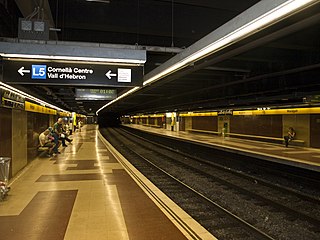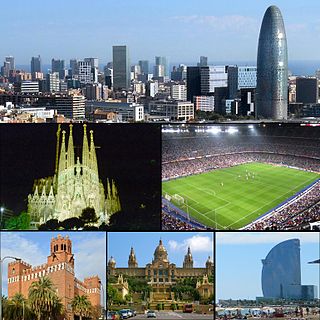
— Line 4, also known as Trinitat Nova – La Pau, usually called "línia groga", is a line in the Barcelona Metro network operated by TMB, and part of the ATM fare-integrated transport network. It serves the northern districts of the city, and it is being extended to the new major metro and rail stations Estació de la Sagrera and Sagrera-Meridiana.
— Line 5, currently known as Cornellà Centre - Vall d'Hebron, its termini, and often called "Línia Blava", is line belonging to the Barcelona Metro network operated by TMB, and part of the ATM fare-integrated transport network.

Avinguda Diagonal is the name of one of Barcelona's broadest and most important avenues. It cuts the city in two, diagonally with respect to the grid pattern of the surrounding streets, hence the name.

Alfons X is a Barcelona metro station, located under Ronda Guinardó and Plaça d'Alfons el Savi, named after Alfonso X of Castile, in the Horta-Guinardó district of Barcelona.

Passeig de Sant Joan is a major avenue in the Eixample and Gràcia districts of Barcelona. It was named after an older street carrying this name, also known as Passeig Nou, built in 1795 around the glacis of the Ciutadella fortress.

Plaça de Lesseps is a square serving as the border between the Sarrià-Sant Gervasi and Gràcia district of Barcelona, Catalonia, Spain, loosely divided in two parts. One of the most heavily transited squares in the city, Lesseps is the starting point of one of Barcelona's busiest rondes: Ronda del General Mitre, as well as being the west end of Carrer Gran de Gràcia and being crossed by a number of streets, namely: Travessera de Dalt, Avinguda del Príncep d'Astúries, Avinguda de Vallcarca, Avinguda de la República Argentina, Carrer del Torrent de l'Olla, Carrer de la Mare de Déu del Coll, Carrer de Santa Perpètua, Carrer de Maignon and Carrer de Pérez Galdós.

Carrer del Carme is a street in central Barcelona, Catalonia, Spain, located in the Raval neighbourhood of the Ciutat Vella district. It is part of the recently revamped commercial area of Raval. This street contains the main offices of Institut d'Estudis Catalans and Societat Catalana de Geografia, as well as the Catholic church Església de Betlem, built in the Baroque style, and the public library Biblioteca Sant Pau-Santa Creu, based in the former building of Hospital de la Santa Creu, which was moved to El Guinardó. The street is notable for being mentioned on the first page of Jean Genet's novel The Thief's Journal.

Mundet is a Barcelona Metro station, in the Horta-Guinardó district of Barcelona, which takes its name from the Recinte Mundet, an adjacent area that now houses a campus of the University of Barcelona. The station is served by line L3.

Montbau is a Barcelona Metro station, in the Horta-Guinardó district of Barcelona, and named after the nearby Montbau neighbourhood. The station is served by line L3.

Vall d'Hebron is a Barcelona Metro station, in the Horta-Guinardó district of Barcelona, and named after the nearby Vall d'Hebron neighbourhood. The station is served by line L3 and is the northern terminus of line L5.

Maragall is a station serving line 4 and line 5 of the Barcelona Metro.

El Poblenou is an extensive neighborhood of Barcelona that borders the Mediterranean sea to the south, Sant Adrià del Besòs to the east, Parc de la Ciutadella in Ciutat Vella to the west, and Horta-Guinardó and Sant Andreu to the north. It is technically part of the Eixample, its layout having been drafted by Ildefons Cerdà, although the historic center of the neighborhood predates the grid.

Ronda de Dalt or B-20 motorway is a ring road or beltway within Barcelona and other parts of its metropolitan area, running from Nus del Llobregat, in l'Hospitalet de Llobregat, to Nus de la Trinitat in the Sant Andreu district of Barcelona. It was completed in 1992 on the occasion of the 1992 Summer Olympics. Parts of the road are completely underground whereas some other look pretty much like other thoroughfares in the city.

Guinardó | Hospital de Sant Pau is a station of the Barcelona Metro, on L4, serving Ronda del Guinardó and Plaça del Guinardó. It opened in 1974. The station is due to become part of double line L9-L10 in the near future.

Montbau is a neighborhood in the Horta-Guinardó district of the city of Barcelona, Catalonia, Spain.

Vall d'Hebron is a neighborhood in the Horta-Guinardó district of Barcelona, Catalonia, Spain.

The following outline is provided as an overview of and topical guide to Barcelona:



















